Full guide to robotic designers from Robotic Station

IMHO there is no better toy in the world than the designer. Before the advent of the computer, iron beams and plastic cubes were out of competition for me - because of them you can create a whole world without any restrictions.
Only having matured, I learned that the children's designer is the pinnacle of the evolution of toys for an invention (rather, even a discovery) that European teachers have spent hundreds of years, step by step, stepping up to the magnificence that we now have in every children's store. If there were no designers, I would not have such a craving for DIY robots.
')
We have a dozen stores with designers at Robostan and a real-life rosh school where real robots are assembled from these designers. That's about it and talk.

But first, a little theory.
A person is distinguished from other animals not by straight walking and an undeveloped brain, first of all we are distinguished by two nuances in the structure of hands. In the first place, only a person’s hand folds into a fist. It’s like a trifle, but it’s a fist that makes a man a “super-predator” - by clenching a fist, a person increases the rigidity of the metacarpophalangeal joints four times, while reducing the impact area increasing its strength three times, but most importantly - a small but heavy fist with sharp knuckles is the perfect device for breaking bones and skulls. For this reason, modern boxers wear gloves, and all found skeletons of ancient people knuckles knocked from the constant "work".

It is not by chance that the American Indians idolize the otter, considered it a "shaman of animals", since This is the only animal in America that a man cannot get with his bare hands - she is too nimble. But since the otter is the only invincible prey, is it possible for all other species to oppose anything to the human hand?

Hand of the Chimpanzee and Homo Sapiens.
In 2012, a large-scale study of the University of Utah (in English) confirmed the obvious: it was and only thanks to our fist that our view occupied the entire planet. It seems that sexual selection was also taking place in the fists. As a result, even the design of our skulls was created primarily to resist fist bumps . That is why the fist is a symbol of a person - remember how many times it has been used in political emblems ( Mouth Front ) or in the same planet of monkeys.
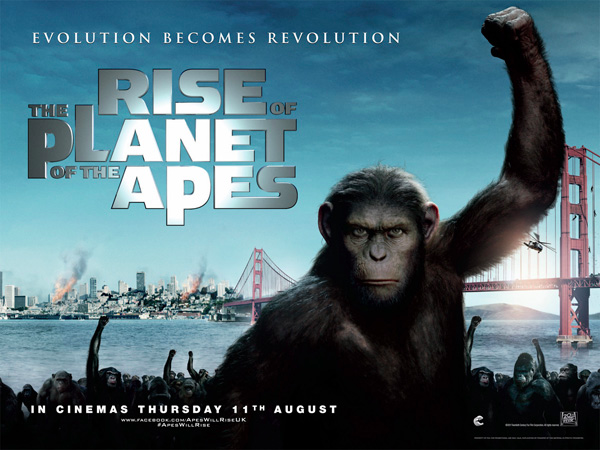
Now you know why this scene is impossible and what it means.
But the fist is not a stupid and brute force. Even if the combat function was primary. On the contrary - to collect a fragile and thin brush in a steel cobblestone is the highest achievement of natural engineering. For the fist, the accuracy and accuracy of movements is inaccessible to any other type on earth. Philosopher I. Kant argued that "the hand is the human brain that has come out." It was the fist that gave us such versatile hands, suitable for the production of guns. How was this achieved?
It turns out our hands are connected to the brain differently than all the other limbs. The fingers and all muscles are directly connected to the motor centers of the brain through monosynaptic connections. Figuratively speaking, our fingers have a direct rigid coupling with the cortex of the cerebral hemispheres - this not only makes the connection faster and more priority than all the other muscles, but also gives feedback.

It is not difficult to see that the hands also occupy a large part of the cortex of the cerebral hemispheres.
It follows that the fingers and the brain are one organ. For example, if your hands are tired, the entire central nervous system will get tired and the brain will get tired and they will say that “your hands do not rise.” It sounds surprising, but it is on this phenomenon that the designer’s idea is built, he consistently leads children through three stages of logical thinking.
The first stage of thinking, characteristic of young children, is called effective. Such thinking can be called "manual" - by manipulating objects, the child learns about their properties. This means that a young child solves all mental tasks with his hands. The greater the stock of actions and the samples accumulate in his experience, the child, the faster he will go to the second stage - visual-figurative, when he will operate not with the objects themselves, but with their images.
At this stage, the child solves the problem, for example, by correctly placing the figures in the corresponding grooves at once, because the tests are performed in the mind. The third stage is verbal-logical or abstract thinking. Here, even practical problems are solved not by hand, but in the mind. Thus, the beginning of the development of thinking gives the hand. As the physiologist I. P. Pavlov said, “hands learn the head, then a wiser head learns the hands, and skillful hands again contribute to the development of the brain.”
That is, the designer gives the child the know-how of abstract thinking. It is through the fine motor skills of the hands that the brain of a modern person acquires basic thinking skills. This is a feature of the designer - it consists of simple universal details, which by their very appearance provoke abstract thinking. There are no such studies, but it is obvious that children who grew up with a designer will overtake their peers in mental activity.
On it we will finish with the theory and we will pass to a history of a question.
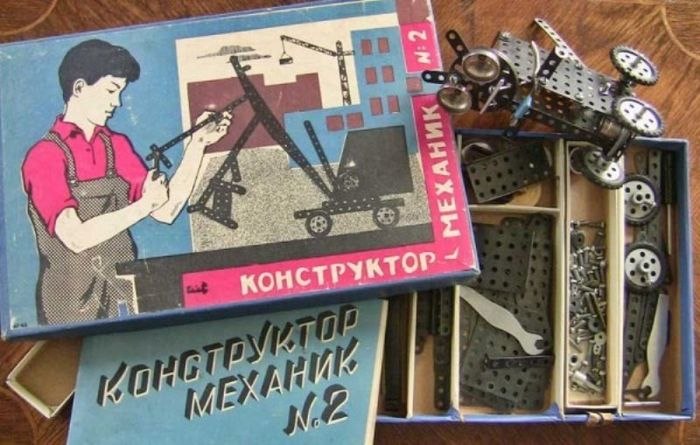
For a long time, many believed that the designers of our childhood is a Soviet invention. However, this is not quite true. The designer in the form of “a set of metal plates with holes, screws and nuts for fastening drilled at equal distances” was invented in 1901 by the Englishman Frank Hornby.

He also owns the invention of the children's railway and mini-models of cars. The successor to the first designer was the company Meccano ( Meccano ). At the end of the term of the patent protection, they began to produce the Soviet analogue - the dream of every Soviet child - the designer called “Youth” and “Designer”. It was produced in the form from simple to complex sets with a different set of parts.

The original idea of Frank Hornby to depict engineering structures in miniature was realized in a children's set of designer for boys. It was called a “mechanical aid for beginners”, was metal and consisted of various beams, angles, ceilings, wheels, brackets and other parts. The set also included nuts, bolts, a screwdriver and a wrench, but there were no specific schemes - each child could show imagination and create a whole city with bridges, cars, airplanes and even flying saucers.
Soon, a new toy, called the "Designer of Meccano", gained extraordinary popularity; and its author, who quickly became a millionaire, wrote a book about himself, which he entitled: "The guy who earned $ 1,000,000 on a toy."
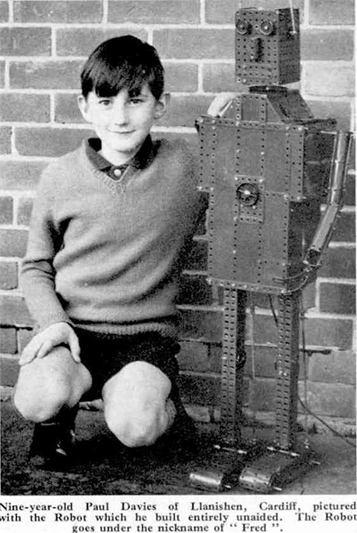
Perhaps the genius designer reaches the peak of world popularity by the beginning of the 1930s, becoming a nominal name. For the pre-war person there is no word “designer”, there is “meccano”.

“The island was cut by strings of roads, - they met at its northeastern rocky part, where glass roofs glittered. This completed the palace, falling three terraces to the waves of a small sandy bay. On the south side of the island, there were buildings similar to the top of the confusion of children's meccano: trusses, fasteners, lattice cranes, rails, running trolleys. ”
AN Tolstoy "Hyperboloid of engineer Garin".
The designer was the main dream until the war itself and was especially appreciated in the USSR - it’s no joke, every pioneer can build a brave new world with his own hands.

The metal designer made in the USSR in 1933.
On April 1, 1932, in the article “Toys - an instrument of communist education”, the newspaper “Pionerskaya Pravda” (No. 38) resented that 90% of the plan for the production of Soviet designers was frustrated: “Instead of meccano ... cans for shoe polish”.
“ ... To look at the toy as if it were fun - the old bourgeois opinion about the toy, it has long been necessary to drop it. The main feature of Soviet toys should be polytechnic. A toy should give the child an idea of modern technology, construction ... ". Thus, from Meccano "grow legs" for all Soviet designers, and your children's metal constructor is its direct descendant.
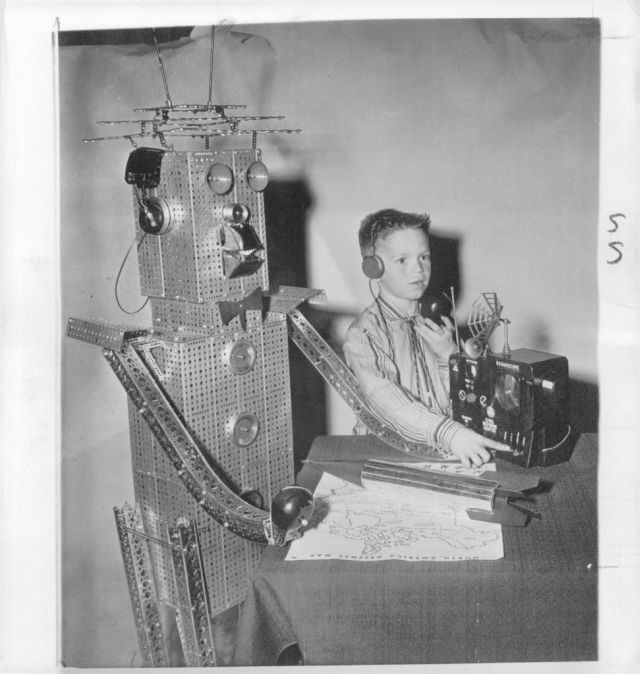
In 1925, the designer’s railway parts also came in handy - Hornby began producing electric toy railways in the standard scale of 1:43 today and direct power from the 110V network.
And in 1933, the company produced a new coup, starting the production of the first “serious” toy machines - the “Modelled Miniatures” set. Two passenger cars, two trucks, a tractor and a tank were made by simple stamping. And here it turns out that it is interesting to play machines not only complete with the railway, as the author intended, but also without it. That is why toy cars are made on the same scale as trains.
Already by the beginning of the war, Hornby brought the lineup up to 300 models, including the only one in the West model of the Soviet car. In 1958, it was this company that came up with many innovations for its machines: spring suspension, opening doors, glazing, tire treads, etc.

So Hornby created, in fact, the entire industry of children's toys. But this does not mean that he was alone. Glory Hornby did not give rest to the Danish Ole Kirk Christiansen, who also wanted to produce toys and founded the company LEGO for this in 1932. At first he made miniature furniture and toy cars - but things did not go very well.

Three LEGO presidents in one photo, 1951.
Ole succeeds in making the next step thanks to the help of Briton Hillary Fisher Page. This becomes a crucial stage in the history of the creation of Lego. As an inventor, Page was also the owner of Kiddicraft. He became interested in creating toys when he was still a child. At the very beginning of the 40s, he began to produce plastic "building blocks", which had slots and protrusions for the connection. The inventor believed that only by understanding the psychology of the child, you can create good toys. Therefore, he spent hours on the playgrounds, playing with their young visitors. He was interested to observe how they use certain subjects.

Christianis in 1947 make an order to England on a molding machine. Suppliers send them product samples, among which there are several "building blocks" of Page. Ole immediately became interested in the idea of universal modules. Modifying the design of the British, he abandons rounded edges, making them straight. He translates the dimensions of the modules into the metric system.

LEGO cubes on top (1949), Kiddicraft cubes on bottom (1947).
In 195b, LEGO engineers finally solve the problem with the strength of cubes by adding hollow cylinders to them. So LEGO acquired a modern look and went to storm the American market.
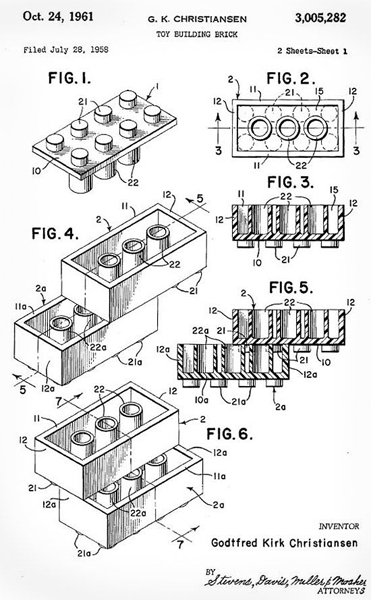
However, we know how cool LEGO is (only six blocks can be assembled at 102,981,500 in different ways!) - but parents in the late 40s were not at all happy about some kind of incomprehensible "plastic" instead of safe wood and metal in toys. Designer just afraid to buy.
In 1960, the company was on the verge of ruin, and the fire destroyed a warehouse with all the wooden toys, and LEGO just had to rely on plastic. They replaced raw materials from cellulose cellulose with non-toxic ABS plastic and spent on advertising. By this time, the Americans had become accustomed to the plastic and things went.
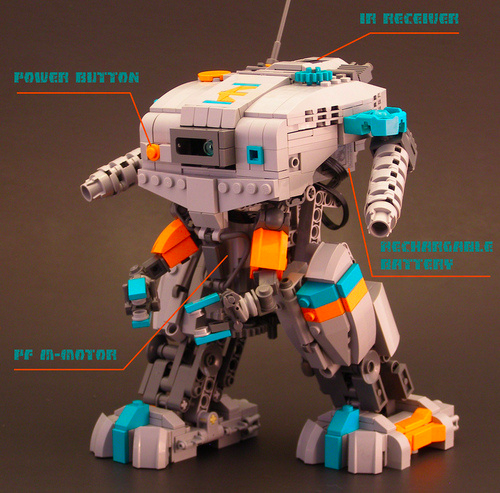
By 1990, 400 billion Lego cubes were produced. If you just put them one on another, then they can connect the Earth with the Moon ten times. In this case, all the cubes from 1949 to 2014 are connected to each other. This is achieved by a serious process technology of 10 microns. In addition, the composition of the plastic includes barium sulfate. This salt does not dissolve in water, which makes it non-toxic to the body, and it is clearly visible on X-rays. Thus, if a child swallows a part, it can be easily found from these pictures.
It seems that nothing foreshadowed trouble. But the company LEGO has forgotten that the designer is only a means to create their own reality. Better that designer, in which you can assemble a complex apparatus. The pinnacle of complexity for designers is robots, which Lego did not have. Therefore, in 2004, the question of bankruptcy arose.
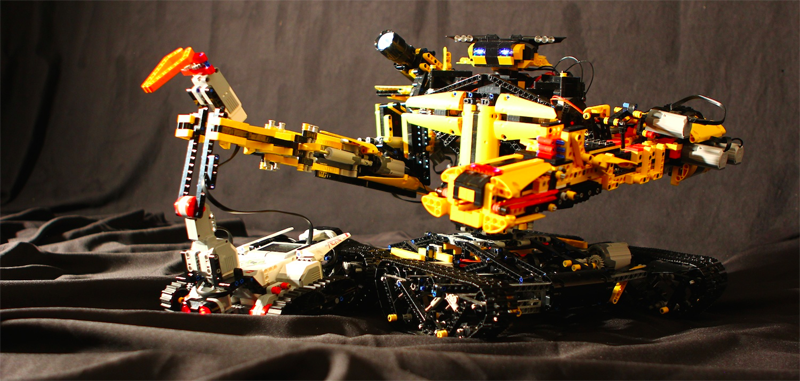
Then, for the first time, the Christiansen family decided to call for the role of the CEO of a person outside the family. They were Jørgen Vig Knudstorp and his view from the side was simple: lego should again become the best designer - you need to again give customers the opportunity to do whatever they want. And who does not want to collect a robot? For example, R2D2?
As a result, LEGO bought licenses for Hollywood movies and invested in robotic kits. In the very first year, the Star Wars set raised sales by 32%, and robots by 18%.
The LEGO Mindstorms NXT series was the first with a more or less functional designer of robots: 577 parts, three servomotors, 4 sensors (distance, sound, touch and illumination) and a central processor with its own “visual” programming language and four behavioral models - Alpha-Rex ( humanoid), Tri-Bot (machine), Robo-Arm T-56 (hand), and Spike (arthropod).

In just one year, the dusty old LEGO again became the most desirable and coolest gift. So the robots saved LEGO from ruin and began to confidently seize the toy market.
But you can't say that Lego is a monopolist here. The market of robot designers is a whole world with its own ecosystem. Roughly speaking, all of them can be divided into five categories.
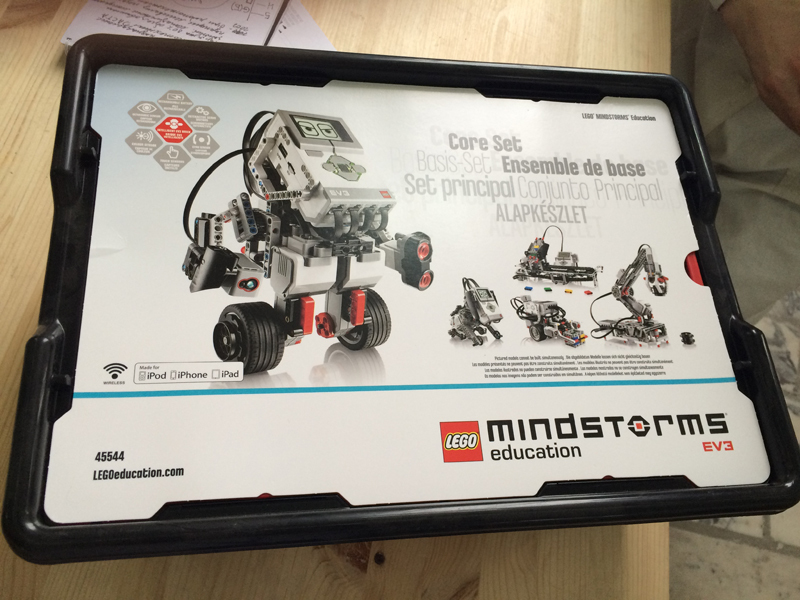
When we say a robotic constructor, we usually mean LEGO Mindstorms EV3 - this is the most massive and versatile constructor.
1. Zero level. From 2 to 6 years. For this age group, designers are developing with a minimal amount of large-sized parts so that the child does not accidentally swallow one of them.
Lego duplo
2. Level "user". 8-9 years. At this age, the child is already able to focus on the creation of something voluminous. The details in such constructors are bigger and the figures are more complicated, but still the child can assemble them independently without the help of parents.
Lego weDo
3. Level "Advanced User". 8-15 years. We begin to assemble the first robots, the details are no longer just cubes, but functional elements, electronics and complex mechanisms appear.
Lego Mindsorm , VEX IQ , German FISCHERTECHNIK , Korean Huna , Russian ScratchDuino .
4. Level Amateur. 10-20 years. We collect complex robots with feedback and decision-making system.
Ampere , Rasbery Pi , Galileo , Bioloid Stem , again Fishertechnik, Trick , VEX EDR and VEX PRO .
Another good idea is additional kits for Lego Mindstorm - Matrix and Tetrix .
5. Level "Profi" - the creation of serious robots capable of performing tasks in the real world.
NI , FPGA .
On the diagram, it all looks clearer:

It is important to note that all designers move towards unification - most of them are hardware compatible and almost all are software. For example, Lego NXT can be controlled by software from any other designer. Corresponding tables can be found on the website of Andrey Guryev: www.slideshare.net/odezia
Virtually all of these robots and designers can be bought directly from us at Robostation - there is no other choice like here in Moscow. We have as many as eight stores: Double Toys , Roys , Copter Express , Shop with toys from the game Minecraft, Robot and I , Sly , MAD Robots and our own production of Ball Robots .
Sorian for the pictures, shot on the phone:

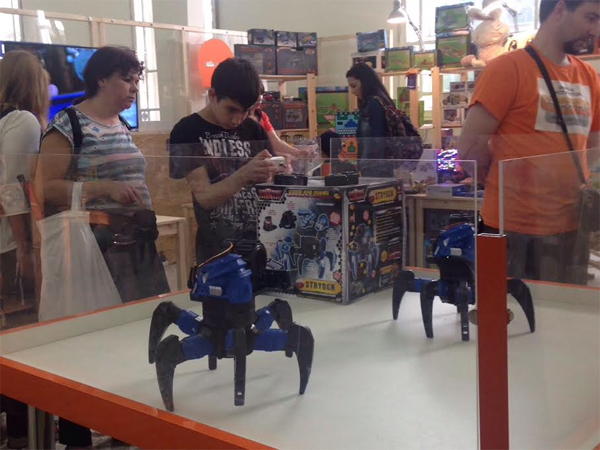
But the designer himself is only 20% of the robot, 80% of the training lies with the teacher for this one can not fail to mention the domestic schools of robotics.
- St. Petersburg - Sergey Filippov, Presidential Physics and Mathematics Lyceum No. 239 .
- Arkhangelsk - Koposov Denis Gennadievich, Gymnasium 24 .
- Chelyabinsk - GEF-Game .
- Novosibirsk - Nikolai Pak and his League of Robots .
- Kazan - Sergey Masyagin and his robotics course in Innopolis .
- Moscow - Sergey Mustafin, school 2017 . Lydia Kobtseva, school 2086 . Andrei Guriev School 1270 - now runs our Roboshkola .
- The Russian Association of Educational Robotics - separately note RAOR , which is very unsuccessfully trying to unite all the robots of designers in the country.
By the way, under the leadership of Guriev, we are in the process of creating our own designer at a rosh school. Here is a presentation to Sobyanin:

As I understand it, the difference will be universality for all ages and tasks that the robot can perform. That is, this level is 15 years old, already available for nine-year-olds. But this is still a prototype, so besides the box, they told me not to show anything - a separate post about it will be released after the designer’s release. While I can show only the description from the box:


Subscribe to our blog and come to the robotic station to collect robots together!
Source: https://habr.com/ru/post/259361/
All Articles